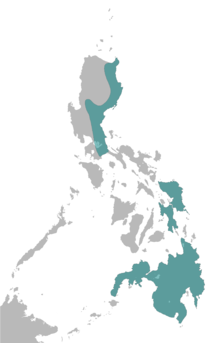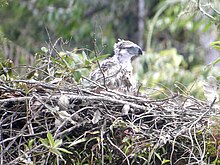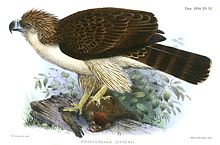Philippine Eagle
| Philippine Eagle | |
|---|---|
 | |
| Conservation status | |
| Scientific classification | |
| Kingdom: | Animalia |
| Phylum: | Chordata |
| Class: | Aves |
| Order: | Falconiformes (or Accipitriformes, q.v.) |
| Family: | Accipitridae |
| Genus: | Pithecophaga Ogilvie-Grant, 1896 |
| Species: | P. jefferyi |
| Binomial name | |
| Pithecophaga jefferyi Ogilvie-Grant, 1897 | |
 | |
| Range in blue green | |
The Philippine Eagle (Pithecophaga jefferyi), also known as the Monkey-eating Eagle, is an eagle of the family Accipitridae that is endemic to forests in the Philippines. It has brown and white-coloured plumage, and a shaggy crest, and generally measures 86 to 102 centimetres (2.82 to 3.35 ft) in length and weighs 4.7 to 8 kilograms (10 to 18 lb). Among the rarest, largest, and most powerful birds in the world, it has been declared the Philippine national bird. It is critically endangered, mainly due to massive loss of habitat due to deforestation in most of its range. Killing a Philippine Eagle is punishable under Philippine law by twelve years in jail and heavy fines.
Taxonomy
The first European to discover the species in 1896 was the English explorer and naturalist John Whitehead, who observed the bird and whose servant, Juan, collected the first specimen a few weeks later. The skin of the bird was sent to William Robert Ogilvie-Grant in London in 1896, who initially showed it off in a local restaurant and described the species a few weeks later.
Upon its discovery, the Philippine Eagle was first called the monkey-eating eagle because of reports from natives of Bonga, Samar, where the species was first discovered, that it preyed exclusively on monkeys; from these reports it gained its generic name, from the Greek pithecus ("ape or monkey") and phagus ("eater of"). The specific name commemorates Jeffery Whitehead, the father of John Whitehead. Later studies revealed, however, that the alleged monkey-eating eagle also ate other animals such as colugo, civets, large snakes, monitor lizards, and even large birds like hornbills. This, coupled with the fact that the same name applied to the African Crowned Eagleand the Central and South American Harpy Eagle, resulted in a presidential proclamation to change its name to Philippine Eagle in 1978, and in 1995 was declared a national emblem. This species has no recognized subspecies.
Apart from Philippine Eagle and Monkey-eating Eagle, it has also been called the Great Philippine Eagle. It has numerous local names, including agila ("eagle"), haribon, haring ibon ("bird king") andbanog ("kite").
Evolutionary history
A study of the skeletal features in 1919 led to the suggestion that the nearest relative was theHarpy Eagle. The species was included in the subfamily Harpiinae until a 2005 study of DNAsequences which identified them as non-members of the group, finding instead, that the nearest relatives are snake eagles (Circaetinae) such as the Bateleur. The species has subsequently been placed in the subfamily Circaetinae.
Description
The Philippine Eagle's nape is adorned with long brown feathers that form a shaggy crest. These feathers give it the appearance of possessing a lion's mane, which in turn resembles the mythicalgriffin. The eagle has a dark face and a creamy-brown nape and crown. The back of the Philippine Eagle is dark brown, while the underside and underwings are white. The heavy legs are yellow with large, powerful dark claws, and the prominent large, high-arched, deep beak is a bluish-gray. The eagle's eyes are blue-gray. Juveniles are similar to adults except that their upperpart feathers have pale fringes.
The Philippine Eagle is typically reported as being 86–102 centimetres (2.82–3.35 ft) long, but a survey at several of the largestnatural history collection in the world found that the average was 95 centimetres (3.12 ft) for males and 105 centimetres (3.44 ft) for females.Based on the latter measurements, this makes it the longest extant species of eagle, as the average for the female equals themaximum reported for the Harpy Eagle and Steller's Sea Eagle.[14] The longest Philippine Eagle reported anywhere and the longest eagle outside of the extinct Haast's Eagle is a specimen of unknown sex at the Field Museum of Natural History (FMNH) that is 112 centimetres (3.67 ft), but it had been kept in captivity and therefore may not represent the wild individuals due to differences in the food availability.[18][19] The level of sexual dimorphism in size is not certain, but it is believed that the male typically is about 10% smaller than the female and this is supported by the average length provided for males and females in one source. For adult Philippine Eagles, the complete weight range has been reported as 4.7 to 8 kilograms (10 to 18 lb),while others have found that the average was 4.5 kilograms (9.9 lb) for males and 6 kilograms (13 lb) for females.It has a wingspan of 184 to 202 centimetres (6.04 to 6.63 ft). The maximum reported weight is surpassed by two other eagles (the Harpy and Steller's Sea Eagle) and the wings are shorter than large eagles of open country (such as the Martial Eagle, Wedge-tailed Eagle and Steller's Sea Eagle), but are quite broad.
The most frequently Additionally, juveniles have been known to beg for food by a series of high-pitched calls.
Distribution and habitat
The Philippine Eagle is endemic to the Philippines and can be found on four major islands: eastern Luzon, Samar, Leyte and Mindanao. The largest number of eagles reside on Mindanao, with between 82 and 233 breeding pairs. Only six pairs are found on Samar, two on Leyte, and a few on Luzon. It can be found in Northern Sierra Madre National Park on Luzon and Mount Apo and Mount Kitanglad National Parks on Mindanao.
This eagle is found in dipterocarp and mid-montane forests, particularly in steep areas. Its elevation ranges from the lowlands to mountains of over 1,800 metres (5,900 ft). It is estimated that only 9,220 square kilometers (2,280,000 acres) of old growth forest remain in the bird's range.However, its total estimated range is about 146,000 square kilometers (56,000 sq mi).
Ecology and behavior
Evolution in the Philippine islands, without other predators, made the eagles the dominant hunter in the Philippine forests. Each breeding pair requires a large home range to successfully raise a chick, and thus the species is extremely vulnerable to deforestation. Earlier it has been estimated that the territory is about 100 square kilometres (39 sq mi), but a study on Mindanao Island found the nearest distance between breeding pairs to be about 13 kilometres (8.1 mi) on average, resulting in a circular plot of 133 square kilometres (51 sq mi).
The species' flight is fast and agile, resembling the smaller hawks more than similar large birds of prey.
Juveniles in play behavior have been observed gripping knotholes in trees with their talons and, using its tail and wings for balance, inserting its head into a tree cavity. Additionally, they have been known to attack inanimate objects for practice as well as attempt to hang upside down to work on their balance.As the parents are not nearby when this occurs, it has been suggested that they do not play a role in teaching the juvenile to hunt.
Life expectancy for a wild eagle is estimated to be anywhere from 30 to 60 years. A captive Philippine Eagle lived for 41 years in Rome Zoo, and it was already adult when it arrived at the zoo. However, it is believed that wild birds on average live shorter lives than captive birds.
Diet
The Philippine Eagle was known initially as the Philippine Monkey-Eating Eagle because it was believed to feed on monkeys (the only monkey native to the Philippines is the Philippine long-tailed macaque) exclusively; this has proven to be inaccurate. The primary prey varies from island to island depending on species availability, particularly in Luzon and Mindanao. This is due to the islands being in different faunal regions. For example, Philippine flying lemurs, the preferred prey in Mindanao, are absent in Luzon. The primary prey for the eagles seen in Luzon are monkeys, birds, flying foxes, giant cloud-rats Phloeomys pallidus which can weigh twice as much as flying lemurs (that is, 2 to 2.5 kg), and reptiles such as large snakes and lizards. The eagles prefer flying lemurs and Asian Palm Civets, but they occasionally eat small mammals, birds (owls and hornbills), reptiles (snakes and monitor lizards), and even other birds of prey. There have been reports of eagles capturing young pigs and small dogs. It is estimated that the flying lemur could make up 90% of the raptor's diet in some locations.
Eagle pairs sometimes hunt troops of monkey cooperatively, with one bird perching nearby to distract the primates allowing the other to swoop in unnoticed for the kill.
Reproduction
The complete breeding cycle of the Philippine Eagle lasts two years. The female matures sexually at five years of age and the male at seven. Like most eagles, the Philippine Eagle is monogamous. Once paired, a couple remains together for the rest of their lives. If one dies, the remaining eagle often searches for a new mate to replace the one lost.
The beginning of courtship is signaled by nest-building and the eagle remaining near its nest. Aerial displays also play a major role in the courtship. These displays include paired soaring over a nesting territory, the male chasing the female in a diagonal dive, and mutual talon presentation, where the male presents his talons to the female's back and she flips over in mid-air to present her own talons. Advertisement displays coupled with loud calling have also been reported. The willingness of an eagle to breed is displayed by the eagle bringing nesting materials to the bird's nest. Copulation follows and occurs repeatedly both on the nest and on nearby perches. The earliest courtship has been reported in July.
Breeding begins between September and February; birds on different islands, most notably Mindanao and Luzon, begin breeding at different ends of this range. The amount of rainfall and population of prey may also affect the breeding season. The nest is normally built on an emergent dipterocarp, or any tall tree with an open crown, in primary or disturbed forest and may be nearly 1.5 metres (4.9 ft) across and about 30 metres (98 ft) above the ground. The eagle's nest resembles a huge platform made of sticks. The eagle frequently reuses the same nesting site for several different chicks. Eight to ten days before the egg is ready to be laid, the female is afflicted with a condition known as egg lethargy. In this experience, the female does not eat, drinks lots of water, and holds its wings droopingly. The female typically lays one egg in the late afternoon or at dusk, although occasionally two have been reported. If an egg fails to hatch or the chick dies early, the parents will likely lay another egg the following year. Copulation may last a few days after the egg is laid to enable another egg to be laid should the first one fail. The egg is incubated for 58 to 68 days after being laid. Both sexes participate in the incubation, but the female does the majority of incubating during the day and all of it at night.
Both sexes help feed the newly hatched eaglet. Additionally, the parents have been observed taking turns shielding the eaglet from the sun and rain until it is seven weeks old. The young eaglet fledges after four or five months.The earliest an eagle has been observed making a kill is 304 days after hatching. Both parents take care of the eaglet for a total of twenty months.
Conservation
In 2010, the IUCN and BirdLife International listed this species as critically endangered.TheInternational Union for the Conservation of Nature believes that between 180 and 500 Philippine Eagles survive in the Philippines.They are threatened primarily by deforestation through logging and expanding agriculture. Old growth forest is being lost at a high rate, and most of the eagle's forest in the lowlands is owned by logging companies.Mining, pollution, exposure to pesticides that affect breeding, and poaching are also major threats.Additionally, they are occasionally caught in traps laid by local people for deer. Though this is no longer a major problem, the eagle's numbers were also reduced by being captured for zoos.
The diminishing numbers of the Philippine Eagle were first brought to international attention in 1965 by the noted Filipino ornithologist, Dioscoro S. Rabor, and the then director of the Parks and Wildlife Office, Jesus A. Alvarez.[27][28][29] Charles Lindbergh, best known for crossing the Atlantic alone and without stopping in 1927, was fascinated by this eagle. As a representative of the World Wildlife Fund, Lindbergh traveled to the Philippines several times between 1969 and 1972, where he helped persuade the government to protect the eagle. In 1969, the Monkey-eating Eagle Conservation Program was started to help preserve this species. In 1992, the first Philippine Eagles were born in captivity through artificial insemination; however, it was not until 1999 that the first naturally bred eaglet hatched. The first captive-bred bird to be released in the wild, Kabayan, was released in 2004 on Mindanao; however, he was accidentally electrocuted in January 2005. Another eagle, Kagsabua, was released March 6, 2008, but was shot and eaten by a farmer.Killing this critically endangered species is punishable under Philippine law by twelve years in jail and heavy fines.
Its numbers have slowly dwindled over the decades to the current population of 180 to 500 eagles. A series of floods and mud slides, caused by deforestation, further devastated the remaining population. The Philippine Eagle may soon no longer be found in the wild, unless direct intervention is taken. The Philippine Eagle Foundation of Davao City, Mindanao is one organization dedicated to the protection and conservation of the Philippine Eagle and its forest habitat. The Philippine Eagle Foundation has successfully bred Philippine Eagles in captivity for over a decade and conducted the first experimental release of a captive-bred eagle to the wild. The foundation has 32 eagles at its center, of which 18 were bred in captivity. Ongoing research on behavior, ecology and population dynamics is also underway. In recent years protected lands have been established specifically for this species, such as the 700 square kilometers (170,000 acres) Cabuaya Forest and the 37.2 square kilometers (9,200 acres) Taft Forest Wildlife Sanctuary on Samar.However, a large proportion of the population is found on unprotected land.
Relationship with humans
The Philippine Eagle was officially declared the national bird of the Philippines on 4 July 1995 by President Fidel V. Ramos under Proclamation No. 615.This eagle, because of its size and rarity, is also a highly desired bird for birdwatchers.
The Philippine Eagle has also featured on at least twelve stamps from the Philippines, with dates ranging from 1967 to 2007. It was also depicted on the 50 centavo coins minted from 1981 to 1994.
Historically, about 50 Philippine Eagles have been kept in zoos in Europe (England, Germany,Belgium, Italy and France), United States and Japan. The first was a female that arrived inLondon Zoo in August 1909 and died there in February 1910.The majority arrived in zoos between 1947 and 1965.The last outside the Philippines died in 1988 in the Antwerp Zoowhere it had lived since 1964 (except for a period at the Planckendael Zoo in Belgium). The first captive breeding was only achieved in 1992 at the facility of the Philippine Eagle Foundation in Davao City, Mindanao, the Philippines, which has bred it several times since then.




No comments:
Post a Comment